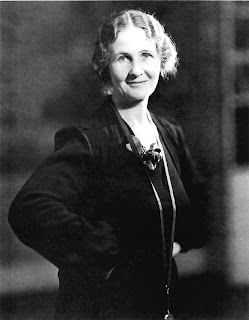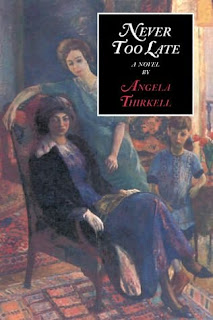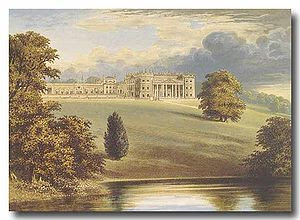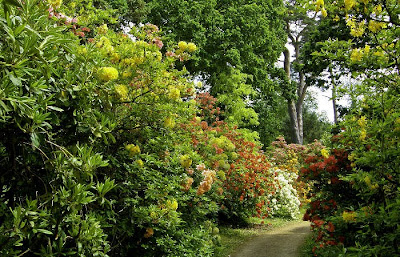 I spent a wonderful weekend with fans of British author Angela Thirkell (1890-1961) at the University of Wisconsin, Madision, August 13-15, 2010. See more about her books here.
I spent a wonderful weekend with fans of British author Angela Thirkell (1890-1961) at the University of Wisconsin, Madision, August 13-15, 2010. See more about her books here.Our conference began with a visit to the Rare Books Collection of the University of Wisconsin-Madison Library. Curator of Special Collections Robin Rider and her staff assembled a fascinating array of volumes which we eagerly explored.
Since Mrs. Thirkell was the granddaughter of Edward Burne-Jones of the Pre-Raphaelite Brotherhood, we saw books related to his work, including many editions published by the Kelmscott Press, founded by William Morris. The volume at left is one of a limited edition of Chaucer, illustrated by Burne-Jones. Many other Kelmscott books were on display as well as volumes written by women travel writers of the early 20th C. (of which Mrs. Thirkell was one) and a volume of bird plates from Australia, where she lived between 1919-1929.
After dinner Dan and Jerri Chase presented an illustrated talk about all the vehicles used in AT’s Barsetshire novels, from donkey carts and horse-crawn carriages to a RollsRoyce Silver Ghost. Dan provided the technical data (his hobby is working with old cars) and Jerri read excerpts from the novels, in which cars are occasionally — well, shall we say — misused by certain rascally young men.
At the conclusion of the evening, Kathleen Fish, organizer of the event and treasurer of the society, invited me to read a bedtime story from a collection of children’s tales written by Angela Thirkell about 1935. I was delighted to be a participant in the festivities. I should also point out that President of the AT Society in North America, Barbara Houlton, had welcomed us all to Madison, even in the middle of a wild rainstorm and severe thunderstorm alert, positively the worst of midwestern weather. Luckily conditions steadily improved until the loveliest of sunny summer days bid us goodbye on Sunday.
 Seven excellent speakers presented talks on Saturday, investigating the many dimensions of AT’s life and work. At right, Sara Bowen speaks on AT and Jane Austen.
Seven excellent speakers presented talks on Saturday, investigating the many dimensions of AT’s life and work. At right, Sara Bowen speaks on AT and Jane Austen.l-r, Kathleen Fish, Sara Bowen, and Susie Fish as Laura Morland, Miss Austen, and again, Mrs. Morland (note the two sweet pea corsages).
Diane Smook of New York wore her mother’s authentic WWII&nb
sp;Red Cross uniform.
L-r, Sunny Gwaltney as Lady Cora, Kathleen Fish, Sara Bowen
Barbara Spieker of Plymouth, WI, scowls as the irascible Aunt Sissie Brandon.
l-r, Victoria Hinshaw as the lady novelist Mrs. Rivers and Dr. Penelope Fritzer of Florida Atlantic University as the lady in the awful green hat! Sorry I have forgotten the character’s name.
l-r, Penny Aldred of London as Mrs. Rivers, special guest Simon McInnes (grandson of Mrs. Thirkell) of Ottawa, Canada, and Alasdair Neil of London, as the butler.
After breakfast on Sunday morning, we held a business meeting and a closing quiz with many, many prizes. All in all, everyone had a great time.
For those of you missed by my camera, you will probably consider yourself quite luckly to have escaped!!
The North American branch of the Angela Thirkell Society will gather again in 2012, probably in New Haven, CN, at Yale University, where Mrs. Thirkell’s papers and first editions are collected at the Beinecke Library. I look forward to the day!


























